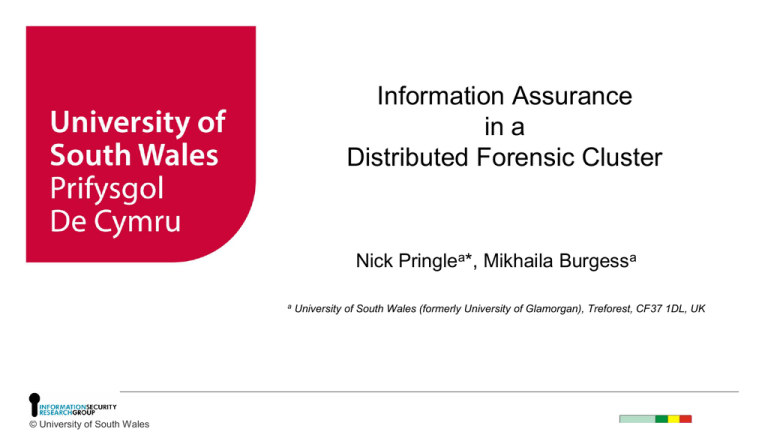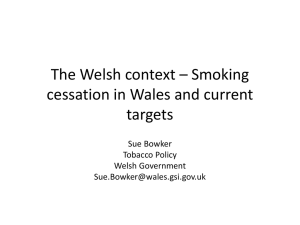pres-pptx
advertisement

Information Assurance in a Distributed Forensic Cluster Nick Pringlea*, Mikhaila Burgessa a © University of South Wales University of South Wales (formerly University of Glamorgan), Treforest, CF37 1DL, UK Introduction • As data quantities increase we will need to adopt alternative models in our forensic processing environments. • We believe that Distributed Processing will play a key part in this. • We believe existing practice breaks down in a distributed system. • We’re going to show our design for a framework that provides data assurance in a distributed storage environment. 2 © University of South Wales “Forensic Soundness” • It’s a key part of our discipline • It’s quite hard to define • Existing standards and frameworks are a little vague • It’s all down to accepted Best Practice • It’s achieved by implementing ‘controls’ 3 © University of South Wales ‘Internal Controls’ on the Forensic Process – By – – – – – – Property, eg. cryptographic hashes, sizes, name! By Location, eg. on specific media, network storage By Authority, eg. order and response form By Access Control, eg. write blocker, password By Separation of Process, eg. crime scene and lab work By Checklist, eg. have all the tasks been completed? By Audit, but this is after the process 4 © University of South Wales At the bedrock of Forensics • The Forensic Image – It’s a snapshot at a point in time – It is complete, including Boot Sectors, Unallocated space, HPA, HPC areas – Rather like the pieces of a Jigsaw, the parts form a whole. – We can measure it with SHA-1 etc 5 © University of South Wales ‘Traditional’ Architectures Based around a ‘Forensic Image’ Forensic Image Stores 6 © University of South Wales A time of Great Change • In ‘the Golden Age’ life was so simple (Simson Garfinkel, 2010) • 3V – Volume, Variety and Velocity (Gartner, 2007) • We now have Desktops, notebooks, netbooks, Virtualisation, Cloud storage, Cloud Processing, Smart Phones, Tablets, SatNav, USB Sticks, Memory cards, Terabyte drives, games machines, Cameras, etc. • We find it difficult to cope with the sheer volume of data • We have a backlog 7 © University of South Wales ‘Traditional’ Architectures Based around a ‘Forensic Image’ This is limited to SATA3 and 32 cores? Forensic Image Stores SATA3 = 600MB/s SSD Read = 500MB/s If 1 Core can process 4 MB/s This could occupy 150 cores Processor constrained Gigabit Network = 100MB/s This can supply only 50 cores Network constrained 8 © University of South Wales Anticipated Developments • • • • Multi tera-byte crime scenes Multi-Agency Access Multi Device Analysis Complex processing, image and object recognition Semantic meaning of text usage profiling • Google had the same type of Problem 9 © University of South Wales Google/Apache Hadoop A processing Model - Map/Reduce A File System - HDfs 1. Split the data as whole files (SIPs/DEBs) across the cluster and 2. Don’t move the data Run the program where the data is stored 10 © University of South Wales Solutions and Opportunities Distributed processing is one that interests me 11 © University of South Wales Distributed Architecture Encrypted and Secure VPN 12 © University of South Wales We lose “The Image” • Distributed storage of acquired information packages is in direct conflict with ‘the image’ • The image’s integrity comes, primarily, from it’s wholesomeness • We lose the integrity we have enjoyed for 20 years • We need to re-establish Assurance 13 © University of South Wales Distributed Data needs to appear as a single file system 14 © University of South Wales Application Program FUSE File-Systems 15 © University of South Wales Application Program FUSE File-Systems 16 © University of South Wales Application Program FUSE File-Systems 17 © University of South Wales FUSE File System in Forensics • • • • • Forensic discovery auditing of digital evidence containers, Richard, Roussev & Marziale (2007) Selective and intelligent imaging using digital evidence bags. In: Proceedings of the sixth annual digital forensics research workshop (DFRWS), Lafayette, IN; Aug 2006. Turner P. Affuse (Simson Garfinkel) MountEWF Xmount for VirtualBox or VMWare format disk images. 18 © University of South Wales FClusterfs – A wish list • The ability to store extended directory/file meta data • We want unaltered legacy software to run. New software requires no new skillset. Sculptor, bulk_extractor etc will still work • Gives access to files on remote servers where they’re stored as whole files • The ability to handle multi storage volumes from different media • Has end to end encryption built-in • Tracks movements and processing: Logging. • Is Read Only to the user • Highly tailorable access control at volume, directory and file levels 19 © University of South Wales Existing FUSE File-Systems • • • • • MySQLfs - Substitutes an SQL database for the file-system CurlFTPfs – Mounts an ftp/ssh/sftp/http/https server Loggedfs – Records all file access activity eCryptfs – Encrypts and decrypts data per file on the fly ROfs – a read only file system 20 © University of South Wales Distributed Data appearing as a single file system FileC MySQLfs FileA eCryptfs CurlFTPfs FileD FileB FileF Directory FileA FileB FileC FileD FileE FileF Loggedfs ROfs FileE 21 © University of South Wales FClusterfs Host A Host B FClusterfs Mount File1 File2 File3 FClusterfs Mount File1 File2 File3 ftp Server File1 ftp Server File2 File3 Remote Connection – Slower - Ethernet Local Connection – Faster – SATA RAM Connection – even faster – BUS speed! fclusterfs --mysql_user=me --mysql_password=mypassword --mysql_host=25.63.133.244 --mysql_database=fclusterfs --volume=74a8f0f627cc0dc6 --audituser='Investigator Name' /home/user/Desktop/fsmount 22 © University of South Wales FClusterfs – MySQL Tables VolumeListing inodes tree metadata serveraccessinfo Password varchar(45) 23 © University of South Wales Our Submission Information Package (SIP/DEB) Header Section <investigator>Nick Pringle</> <case>A Villainous Crime</> <date-time>12/May/2013 14:25:23</> <description>This is a small 1GB memory stick taken from the desk of the suspect</><ScanStartedAt>Friday, November 29 2013. 13:42:52 GMT</> <ThisFileScannedAt>Friday, November 29 2013. 13:42:52 GMT</> <VolumeSerialNo>74a8f0f627cc0dc6</> <VolumeLabel>My Label</> <FileName>/mhash/lib/keygen_s2k.c</> <NTFSDumpFileAttributes> Dumping attribute $STANDARD_INFORMATION (0x10) from mft record 150 (0x96) Resident: Yes Attribute flags: 0x0000 <data> 0x00 begin-base64 777 FC0198EF2F7782EF9EA8568853E6E3A48B86256D.cpt <FileAttributes> ARCHIVE (0x00000020)</> Dlevh4eFxd761tZ1zaPShNPDvGkB1FZn8UJiMY3zLCOAWKyj5CiPQSQOEGdU Dumping attribute $FILE_NAME (0x30) from mft record 150 (0x96) Resident: Yes KzhQCN3oG0Xh27lSyydHHwA7cCSeRS012Sv74NF16GixZ4f8qx7fMwtV73Ld Resident flags: 0x01 W9K53EwHUGnbHUw6WEOm0wh9ch8QvJcPcPvW3oIdQAA0HEBaB45I3XOaAr95 Parent directory: 136 (0x88) Yq37pBkMblDlC+/fu5ueFt6voIcPM9tD53GrO0G0T/6wAaPAqNEDWcCZTztj File Creation Time: Sat Jul 20 18:25:53 2013 UTC File Altered Time: Sat Jul 20 18:25:53 2013 UTC bRH+FELEM9rxZidX8/glPd/UBXbgZ/IjSIsknIsZG+KMZhJg1AWxmniKj633 MFT Changed Time: Sat Jul 20 18:25:53 2013 UTC A0qeD/Fny9gj1i7f2RhCWrd78y2fXKt4YA/nM4osibDh1o9QsiGTjtrkdFM4 Last Accessed Time: Sat Jul 20 18:25:53 2013 UTC fy4rHA6w98UdIwvROiH+roMKx0twdiDgy+zlvgvSohF9PKMn5Nq7Y4KLw19k Dumping attribute $DATA (0x80) from mft record 150 (0x96) Resident: No p53JixBHilkoKefebVTybKNxNMh6c4QiNZucKQqRQWvVlYMgwqVbzqWiJQPM Attribute flags: 0x0000 5Mzhks7gDqZCx5s5QIl99w9fczGwurXn9yMjnNzGurFG32fo8ve/hoEAgsO6 Attribute instance: 2 (0x2) slJ3/suViTtD+L97BrPqrsnkSv/gOr3aldEfstRgiA0A/v7ApAP6zDOe0TXD Compression unit: 0 (0x0) Actual Data size 6066 (0x17b2)</> HHZ3OkRfopu4HAy+k234k6HQRkvveoS2T53Jz6HrCSplAh2xqpMjRiTl5PF+ Allocated size: 8192 (0x2000) EpiHiyy3w8zX5oAgNMdkm/Nwv+CwESi8JnAbaCkcOEbiusNfjtxsF/SnaDPq <<<Initialized size>>>: 6066 (0x17b2) CzX2ezaKu9ElvLcqYDJA2ycQFw4MXy3Vr4gXNdg456Ael7nJbtfARZFrchg8 <TotalRuns>1</><Fragments>1</> <run>1</><cluster1>242416</><sha1>A8724ACDB2135FE66EB7BE554CCF16091FBC2664</> /bhN5itxLOda8/BjMlsA9zE9cXAPUM3W5bANniu75AXkbrI6yQDpsO5Kdf0Y <run>1</><cluster2>242417</><sha1>D7A6B1A3F17E33A1F15BF8B815EC4B13410EFED3</> </data> <WholeFileSHA1>FC0198EF2F7782EF9EA8568853E6E3A48B86256D</> <NTFSInodeGeneralInfo> Data Section 24 © University of South Wales FClusterfs – MySQL Tables VolumeListing inodes tree WorkflowTasks nodestate metadata serveraccessinfo Password audit varchar(45) 25 © University of South Wales FCluster Architecture Roles and Zones • • • • • • • • Acquisition Authority Imager FClusterfs metadata storage Metadata Import/Load Balancer Replicator Data Storage Server Processing Server Results Meta Data table 26 © University of South Wales Assurance Zones – Acquisition - Overview 1. 2. 3. The cluster issues an “authority to image”. This includes a “one time use” key to be used to encrypt the evidence. The imaging device creates the image, SIP/DEB of the file directory and SIP/DEBs of the file data which are encrypted using the one time use key. SIP/DEBs are pushed/pulled to the cluster 27 © University of South Wales Assurance Zones – Acquisition – Detail 1 of 6 28 © University of South Wales Assurance Zones – Acquisition – Detail 2 of 6 29 © University of South Wales Assurance Zones – Acquisition – Detail 3 of 6 30 © University of South Wales Assurance Zones – Acquisition – Detail 4 of 6 31 © University of South Wales Assurance Zones – Acquisition – Detail 5 of 6 32 © University of South Wales Assurance Zones – Acquisition – Detail 6 of 6 33 © University of South Wales Assurance Zones – Metadata Import – Detail 1 of 6 35 © University of South Wales Assurance Zones – Metadata Import – Detail 2 of 6 36 © University of South Wales Assurance Zones – Metadata Import – Detail 3 of 6 37 © University of South Wales Assurance Zones – Metadata Import – Detail 4 of 6 38 © University of South Wales Assurance Zones – Metadata Import – Detail 5 of 6 39 © University of South Wales Assurance Zones – Metadata Import – Detail 6 of 6 40 © University of South Wales Assurance Zones – Distribution - Overview 1. 2. 3. 4. Each SIP/DEB is read and only if it is expected, ie found in the inodes table, it is copied to the location as recorded in the inode table The SIP is unpacked, decrypted and header data added to the meta-data table The inodes table is updated with the storage data status In due course, the SIP/DEB will be replicated to 2 other locations and the inodes table updated accordingly. 41 © University of South Wales Assurance Zones – Distribution – Detail 1 of 2 42 © University of South Wales Assurance Zones – Distribution – Detail 2 of 2 43 © University of South Wales Assurance Zones – Processing - Overview 1. Using the processing table, a standard set of tasks is run on the data stored locally on the host 2. Results are usually recorded as XML formatted data in the results table within the same database referenced by inode number. 44 © University of South Wales Assurance Zones – Processing – Detail 1 of 1 45 © University of South Wales Audit 46 © University of South Wales Mounting the file system 1 Connect to a database 3 Choose a mount point The mounted FClusterfs file system is indistinguishable from a ‘normal’ file system 2 Select a file system from multiple available 4 Mount 47 © University of South Wales Latency and Multi-threading and Parallel Processing Task setup Processing Task closure Linear Processing Multi-Threading/ Parallel/ Distributed Processing 48 © University of South Wales Why is this the right approach? • This could be achieved within an application program but each package would to implement it and gain approval. • Working at file system level the efficacy is global • Interaction with FClusterfs is unavoidable • Fclusterfs controls data access and maintains Assurance 49 © University of South Wales In Summary • Distributed processing is a prime candidate to reduce the backlog but there are problems • We lose ‘the image’; one of the foundations that has evolved in digital forensics over the last 20 years • We can replace it by learning from, not adopting, Hadoop 50 © University of South Wales Funded by… 51 © University of South Wales Information Assurance in a Distributed Forensic Cluster Questions? 52 © University of South Wales







